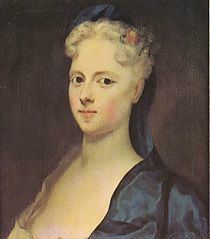Religion Lutheranism Parents Conrad von Reventlow | Mother Anna Gabel Name Anne Reventlow Grandparents Ditlev Reventlow | |
 | ||
Tenure 4 April 1721 – 12 October 1730 Issue Fredericka Sophie ReventlowFredericka Conradine ReventlowStillborn childPrincess Christiana AmaliaPrince Frederik ChristianPrince Charles Similar People Frederick IV of Denmark, Christian VI of Denmark, Christian Ditlev Frederik, Sophie Amalie of Brunswick‑Luneburg, Christian V of Denmark | ||
Anne Sophie Reventlow (Danish: Anna Sophie; 16 April 1693 – 7 January 1743) was Queen of Denmark and Norway from 1721 to 1730 as the second wife of Frederick IV of Denmark and Norway.
Contents
Early life
She was born a komtesse (countess) as the daughter of Conrad, Count Reventlow of Clausholm, who served Frederick IV as Grand Chancellor from 1699 until his death in 1708. About Anna Sophie's childhood nothing is known apart from the fact that her upbringing was educationally inadequate: Answered letters show that she made clumsy use of Danish, French and German. She was described as beautiful and lively, with "black, fiery eyes."
Spouse by bigamy
In 1711 the King encountered Anne Sophie at a masquerade ball in Koldinghus, where the royal family resided that season. He wanted her to become his mistress, which her mother refused to allow. The king abducted her on 26 June 1712 from her parent's estate, Clausholm, with the apparent support of her half-sister Christine Sophie and her husband Count Ulrik Adolph Holstein of Holsteinborg (1664-1737). That same year the King took her to Skanderborg castle, where they were married morganatically in a wedding ceremony conducted by Thomas Clausen.
The king installed Reventlow in a house on Bag Borsen (present day Slotsholmsgade 8), close to Christiansborg Palace, in Copenhagen. The King's consort was still alive. However, he had committed bigamy once before, with Elisabeth Helene von Vieregg. The church authorities had not forbidden the king to engage in polygamy, as there were doctrines based on the biblical polygamy of Hebrew patriarchs. She was made Duchess of Schleswig. In 1713, she was given Vallo as a fief.
Queen
On 4 April 1721, soon after the death of Queen Louise, Frederick IV married Anne Sophie a second time. This time, the wedding was formal and conducted with grand ceremony. Nor was this marriage declared morganatic, although it was regarded as scandalous by the Danish nobility and foreign courts alike, marriages of rulers to subjects having come to be regarded as unequal.
The King had Anne Sophie crowned as queen at a hastily improvised ceremony at Frederiksberg Castle in May 1721. Afterwards, she presided at the King's entry into the capital. She was Denmark's first non-royal queen consort since Ulvhild Hakansdotter nearly 600 years earlier. Anne Sophie gave birth six children, three born before the official marriage (so they used the surname Reventlow) and three born after the official marriage (who where styled as Princes of Denmark), but any of them survive infancy; this was seen by members of the clergy and nobility as punishment for the bigamy.
Crown Prince Christian, who had been close to his mother, detested Anne Sophie. Her brother-in-law, Prince Charles, and sister-in-law, Princess Sophia Hedwig, withdrew from the court in Copenhagen to Vemmetofte in protest, although her stepdaughter Charlotte Amalie showed her kindness. In 1725, the King made a will in which he ensured the rights of Anne Sophie after his death and made his son sign it.
Queen Anne Sophie's relatives, members of the Reventlow and Holstein families — popularly known as the "Reventlow Gang" — were placed in high positions. Her sister, the salonist Countess Christine Sophie Holstein, called "Madame Chancellor", exerted influence over affairs of state. Anne was blamed for the nepotism, but it is not known whether she actually exercised political influence, or if the King wished to consolidate her role at court. Her recommendation was important for anyone who sought the King's favour. Due to the generosity of her donations to widows and the poor, she came to be called "The Protector of the Poor".
Issue
Anne Sophie Reventlow and King Frederick IV had six children:
Exiled widowhood
After Frederick IV's death in 1730, she was expelled from Copenhagen to her birthplace, Clausholm Castle near Randers in Jutland. She was styled "Queen Anne Sophie", not "Queen Anne Sophie of Denmark and Norway" or "Queen Dowager". She spent the rest of her life in religious seclusion, under virtual house arrest on her estate, which the king did not allow her to leave without his express permission. Upon her death, King Christian VI allowed for public mourning and arranged to have her buried in Roskilde Cathedral, although to keep her from being buried with his father in the retroquire, he purchased the Trolle family chapel in the west end of the cathedral, and arranged for her and her children to be buried there.
